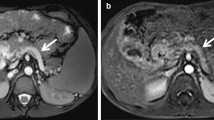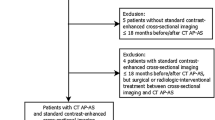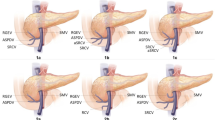Abstract
Aim
The purpose of this study was to evaluate the capability of contrast-enhanced three-dimensional (3D) MR portography in detecting abnormal findings associated with the portal venous system compared with the results of color Doppler ultrasonography (CDUS).
Materials and methods
MR portography findings were retrospectively compared with the results of CDUS examinations in 161 patients, who were suspected of having portal venous system abnormalities. Portal venous vessels were divided into main 5 groups including the main portal vein, its left and right intrahepatic branches, splenic vein and superior mesenteric vein. Imaging findings were classified as normal, occluded, or partially thrombosed. Results of clinical and imaging follow-up examinations including CDUS, MR portography or angiography, if available, were used as a proof of final diagnosis. The potential sites of varicose veins and collateral vessels were also examined by both imaging methods.
Results
Vascular abnormalities were identified in 79 of 161 patients. There was a statistically significant agreement between the results of MR portography and CDUS in evaluating portal venous system (κ = 0.871, P < 0.05). The sensitivity of MR portography was slightly superior to CDUS in detecting partially thrombosis and occlusion in the main portal venous vessels. In addition, MR portograms were superior to CDUS in the management of patients with portal hypertension by identifying portosystemic collaterals more adequately, and clearly demonstrated portal venous vessels that cannot be visualized at CDUS.
Conclusion
Results of present study indicates that contrast-enhanced 3D MR portography is well suited and superior to CDUS in the management of patients with portal hypertension.




Similar content being viewed by others
References
Yamashita Y, Mitsuzaki K, Miyazaki T, et al. (1996) Gadolinium-enhanced breath-hold three-dimensional MR angiography of the portal vein: value of the magnetization-prepared rapid acquisition gradient-echo sequence. Radiology 201(1):283–8
Stafford-Johnson DB, Hamilton BH, Dong Q, et al. (1998) Vascular complications of liver transplantation: evaluation with gadolinium-enhanced MR angiography. Radiology 207(1):153–60
Saddik D, Frazer C, Robins P, Reed W, Davis S (1999) Gadolinium-enhanced three-dimensional MR portal venography. AJR 172(2):413–7
Kopka L, Rodenwaldt J, Vosshenrich R, et al. (1999) Hepatic blood supply: comparison of optimized dual phase contrast-enhanced three-dimensional MR angiography and digital subtraction angiography. Radiology 211(1):51–8
Sadick M, Diehl SJ, Lehmann KJ, et al. (2000) Evaluation of breath-hold contrast-enhanced 3D magnetic resonance angiography technique for imaging visceral abdominal arteries and veins. Invest Radiol 35(2):111–7
Erden A, Erden I, Karayalcin S, Yurdaydin C (2002) Budd-Chiari syndrome: evaluation with multiphase contrast-enhanced three-dimensional MR angiography. AJR 179(5):1287–92
Kreft B, Strunk H, Flacke S, et al. (2000) Detection of thrombosis in the portal venous system: comparison of contrast-enhanced MR angiography with intraarterial digital subtraction angiography. Radiology 216(1):86–92
Prince MR, Arnoldus C, Frisoli J (1996) Nephrotoxicity of high-dose gadolinium compared with iodinated contrast. J Magn Reson Imaging 6(1):162–6
Lavelle MT, Lee VS, Rofsky NM, Krinsky GA, Weinreb JC (2001) Dynamic contrast-enhance three-dimensional MR imaging of liver parenchyma: source images and angiographic reconstructions to define hepatic arterial anatomy. Radiology 218(2):389–94
Prince MR, Chenevert TL, Foo TKF, et al. (1997) Contrast-enhanced abdominal MR angiography: optimization of imaging delay time by automating the detection of contrast material arrival in the aorta. Radiology 203(1):109–14
Pieters PC, Miller WJ, DeMeo JH (1997) Evaluation of the portal venous system: complementary roles of invasive and noninvasive imaging strategies. Radiographics 17(4):879–95
Okumura A, Watanabe Y, Dohke M, et al. (1999) Contrast-enhanced three-dimensional MR portography. Radiographics 19(4):973–87
Glockner JF, Forauer AR, Solomon H, Varma CR, Perman WH (2000) Three-dimensional gadolinium-enhanced MR angiography of vascular complications after liver transplantation. AJR 174(5):1447–53
Tessler FN, Gehring BJ, Gomes AS, et al. (1991) Diagnosis of portal vein thrombosis: value of color Doppler imaging. AJR 157(2):293–6
Parvey HR, Eisenberg RL, Giyanani V, Krebs CA (1989) Duplex sonography of the portal venous system: pitfalls and limitations. AJR 152(4):765–70
Naik KS, Ward J, Irving HC, Robinson PJ (1997) Comparison of dynamic contrast-enhanced MRI and Doppler ultrasound in the preoperative assessment of the portal venous system. Br J Radiol 70(1):43–9
Erden A, Erden I, Yagmurlu B, et al. (2003) Portal venous system: evaluation with contrast-enhanced 3D MR portography. Clin Imaging 27(2):101–5
Mostbeck GH, Wittich GR, Herold C, et al. (1989) Hemodynamic significance of the paraumbilical vein in portal hypertension: assessment with duplex US. Radiology 170(2):339–42
Lin J, Zhou KR, Chen ZW, et al. (2003) Three-dimensional contrast-enhanced MR angiography in diagnosis of portal vein involvement by hepatic tumors. World J Gastroenterol 9(5):1114–8
Leyendecker JR, Rivera E, Washburn WK, et al. (1997) MR angiography of the portal venous system: techniques, interpretation, and clinical applications. Radiographics 17(6):1425–43
Author information
Authors and Affiliations
Corresponding author
Rights and permissions
About this article
Cite this article
Cakmak, O., Elmas, N., Tamsel, S. et al. Role of contrast-enhanced 3D magnetic resonance portography in evaluating portal venous system compared with color Doppler ultrasonography. Abdom Imaging 33, 65–71 (2008). https://doi.org/10.1007/s00261-007-9229-x
Published:
Issue Date:
DOI: https://doi.org/10.1007/s00261-007-9229-x




